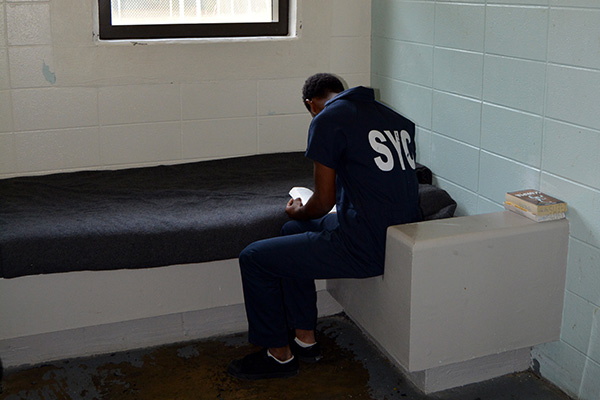Youth in the correctional system are sign of family, community problems
By Martha Simmons
Correspondent, The Alabama Baptist
Still wearing his black robe, weary Circuit Court Judge Edmond Naman sits at a massive desk piled high with files and paperwork associated with the largest and busiest juvenile court district in Alabama.
It’s early but Naman’s already been on the bench for several hours, and a long day of hearings and meetings and phone calls stretches before him.
While the uninitiated might think of a juvenile detention facility as something of a kiddie jail, the James T. Strickland Youth Center — known simply as “Strickland” to Mobile residents — is much more than that. It is the place where splintered families, society’s neglect and institutional failures intersect on the daily docket.
In many ways Strickland represents ground zero of the life-and-death struggle for the soul of the community, Naman said. “It’s a soul fight, is what it is.”
Strickland has three facilities located on a 15-acre campus: the juvenile court; a juvenile detention center equipped to house 71 boys and 24 girls ages 12 through 17; and a 12-bed crisis center for children in need of supervision (known as CHINS).
Juveniles are defined as children up to age 17 and are generally covered under laws that take their ages and stages of development under consideration.
Under Alabama law children age 16 and above who are charged with a violent crime are automatically transferred to the adult jail and tried as adults.
Variety of complaints
As the juvenile court’s presiding judge, Naman is assisted by two court referees and a district judge. Together they handle more than 8,900 complaints each year relating to juvenile delinquency, truancy, children in need of supervision, child custody, child support, involuntary commitments and contributing to the delinquency of minors.
A somber parade passes through Strickland’s metal detectors each day. Panicked or drug-addicted parents, violent or neglected children, uniformed law enforcement and detention officers, sparring prosecutors and attorneys and harried social workers fill the waiting area and courtrooms. Counselors and other social service providers meet with families in an effort to address the circumstances contributing to children’s involvement with the justice system. Juvenile probation officers in the circuit’s jurisdiction monitor the progress of an average 1,700 youth.
For all the government resources that are thrown at the issue of juvenile delinquency through Strickland’s $6.5 million per year operation and all its partner agencies, it simply isn’t enough. The problem is too systemic, rooted deeply in splintered families, substance abuse, physical abuse and neglect, educational failure, abject poverty and, above all, hopelessness. “I see the bravery of these children,” he said. “I would wilt after one day of living the way that they do, day in and day out.”
A look at the numbers
The judge sifts through the stacks of paper and rifles through file drawers until he comes up with two sets of statistics. They are the numbers behind the faces he sees coming through his court each day.
One set of stapled charts outlines the juvenile crimes that have churned through the Mobile County court system for the past decade — felonies such as burglary and murder, weapons charges and drug dealing as well as status offenses such as truancy and under-age drinking.
Such crime statistics are the predictable outcome of the data reflected in the second set of charts, the annual Kids Count report on the well-being of the nation’s children, Naman indicated. That report traces the markers for children’s health, safety, economic security and educational attainment.
The numbers are discouraging. In 2017, Alabama ranked 44th among 50 states in overall child well-being. And in Naman’s jurisdiction Mobile County ranked 39th of the state’s 60 counties. (For the most updated information about your county’s children, access the 2018 Alabama Kids Count report here: https://alavoices.org/wp-content/uploads/2018/10/2018_DatabookComp_web_FNL.pdf.)
Being on the bottom rung of such statistics plays out every day in the court, Naman said, noting the overwhelming majority of the children he deals with live in poverty and are being raised by a single parent or grandparent. There’s also significant homelessness.
“These families are living in crisis,” he said. “There’s so much brokenness in these families — hopelessness, violence, drugs, abuse, neglect. There’s so much we’re battling. DHR is doing a good job but they’re overwhelmed. The Mobile County Public School System’s failing schools correspond exactly to where these kids are living. We’re just not set up to deal with the social issues we’re dealing with,” Naman said.
“We can only do so much and then at some point we can’t do anymore. We’re failing these kids. We’re failing them because we don’t have the resources. And when we fail you see it in the headlines.”
The help must come from outside the taxpayer-funded agencies groaning under an ever-increasing caseload, many experienced in the work contend. And the faith community is a critical component in addressing unmet needs for children and families at the bottom of the social food chain.
Important interventions
For instance, Naman said, faith-based efforts like the Alabama Baptist Children’s Homes & Family Ministries (ABCH), with locations throughout the state, provide important interventions for broken families. In Mobile the ABCH Family Care ministry provides struggling mothers and their children with transitional housing while the mothers gain employment, save money, receive counseling and learn life skills such as budgeting and parenting.
The need for such resources far outpaces their availability. People of faith can make the difference, Naman said. “We can’t fight this war alone.
“The statistics are horrible,” he noted as he sets the charts and graphs down on his cluttered desk. “But they don’t show the eyes behind the numbers, do they? They don’t show the hopelessness and fear and poverty. We need to look into the eyes of these children and see their souls.
“We’ve got to take care of the least among us in this community,” said the judge. “If not for God, then for our own self-preservation.”
_____________________________________________________________________________
NEST of Mobile partners with court to mentor families
By Martha Simmons
Correspondent, The Alabama Baptist
One caring adult can change the whole trajectory of a child’s life, asserts Edmond Naman, Mobile County’s juvenile court judge.
“In a lot of cases there’s not one real responsible person in these kids’ lives,” Naman said of the children he sees each day at James T. Strickland Youth Center. “There’s nobody who’s inspiring them or fighting for them. They need that one important person who says, ‘I’m not going to let you fail.’ A kid can walk around trouble if he has someplace to walk to and someone to walk with.”
To connect these kids with adults who can be that “one important person,” Naman joined forces with other faith and community leaders in the summer of 2012 to co-found the NEST of Mobile mentoring program. NEST takes its name from their effort to “nurture children, equip parents, strengthen families and transform communities.”
NEST matches teams of two or more court-approved volunteers with at-risk youth and families, working with the Mobile County Juvenile Court, the Department of Human Resources and other partnering agencies to match teams with youth referrals. NEST volunteers help kids and families address basic needs ranging from employment to school supplies. The volunteers also mentor them on life skills such as budgeting and meal planning. While each team signs up to work with the family during the court probationary period of up to six months, the overarching goal is for the team and family to develop a lifetime relationship.
Although a relatively young organization NEST is delivering some good statistics of its own. A University of South Alabama study found that only 26 percent of probationary youth served by the NEST program re-offended. That’s a significant accomplishment when compared with the statewide juvenile recidivism rate of 66 percent, and the national rate of 50–68 percent.
Ambitious goal
Currently NEST is fielding about 27 teams who are serving more than 30 youth and family members, but Naman hopes that number reaches at least 100. It’s an ambitious goal but one that Naman insists must be achieved if Mobile County is ever going to rise above its poor ranking in child well-being and crime statistics.
And even more important, the judge said, is each individual reflected in those numbers.
Thomas Haney is one of those individuals.
The 18-year-old Haney showed up at Strickland Youth Center last spring, hoping to help his mother maintain custody of his siblings. Haney, whose biological father was in prison, lived in a bus with his drug-addicted mother, her boyfriend and one of his siblings.
At age 18, Haney had aged out of the services that could be provided through the juvenile court or social services, and Naman, who still had a couple dozen cases to hear that day, almost sent him away.
“I just didn’t know what to do. He was 18,” Naman said. “I felt I had failed God in letting him leave. There was nothing I could do … except call him back.”
After talking more with Haney and learning of his dire home situation, Naman connected the young man with Mike O’Neill, a NEST of Mobile contributor who owns an industrial supply business in Pensacola. O’Neill looked past Haney’s dire family situation and into the young man’s eyes. He offered Haney a full-time job at the warehouse and a studio apartment at the work site to live in.
“Not a week later,” Naman recalled, “Thomas’s mother and her boyfriend were arrested for drugs.” Had the young man still lived there, Naman said, he probably would have been swept up in the arrest too, “but God in His wisdom had already set things in motion.” As a result of the NEST intervention Haney was already out of harm’s way and looking toward a future that seemed unattainable only a few weeks earlier.
Giving God credit
He’s back on track to obtain his high school diploma in May, after which he hopes to join the U.S. Marine Corps and become a registered nurse. As for his family situation, Haney said he does not maintain any contact with his father but that his mother is “clean and working full time with benefits.” His 15-year-old sibling is now in foster care and the youngest, a five-year-old, is being cared for by his grandmother.
Like Naman, Haney gives God the credit for his life’s dramatic turnaround.
“God has given me the ability to put down any outside influences, to think like an adult and to look to the future,” Haney said.
As for Naman, O’Neill and the other NEST of Mobile volunteers, Haney said, “From the time I met them, all they’ve ever done is care. They are truly angels sent from God.”
To find out more about how to volunteer or support NEST, go to http://www.nestofmobile.org.






Share with others: